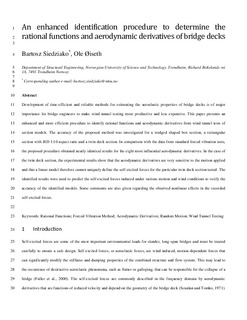| dc.contributor.author | Siedziako, Bartosz | |
| dc.contributor.author | Øiseth, Ole | |
| dc.date.accessioned | 2019-02-19T13:26:06Z | |
| dc.date.available | 2019-02-19T13:26:06Z | |
| dc.date.created | 2018-10-27T14:22:57Z | |
| dc.date.issued | 2018 | |
| dc.identifier.citation | Journal of Wind Engineering and Industrial Aerodynamics. 2018, 176 131-142. | nb_NO |
| dc.identifier.issn | 0167-6105 | |
| dc.identifier.uri | http://hdl.handle.net/11250/2586313 | |
| dc.description.abstract | Development of time-efficient and reliable methods for estimating the aeroelastic properties of bridge decks is of major importance for bridge engineers to make wind tunnel testing more productive and less expensive. This paper presents an enhanced and more efficient procedure to identify rational functions and aerodynamic derivatives from wind tunnel tests of section models. The accuracy of the proposed method was investigated for a wedged shaped box section, a rectangular section with B/D 1:10 aspect ratio and a twin deck section. In comparison with the data from standard forced vibration tests, the proposed procedure obtained nearly identical results for the eight most influential aerodynamic derivatives. In the case of the twin deck section, the experimental results show that the aerodynamic derivatives are very sensitive to the motion applied and that a linear model therefore cannot uniquely define the self-excited forces for the particular twin deck section tested. The identified results were used to predict the self-excited forces induced under various motion and wind conditions to verify the accuracy of the identified models. Some comments are also given regarding the observed nonlinear effects in the recorded self-excited forces. | nb_NO |
| dc.language.iso | eng | nb_NO |
| dc.publisher | Elsevier | nb_NO |
| dc.title | An enhanced identification procedure to determine the rational functions and aerodynamic derivatives of bridge decks | nb_NO |
| dc.title.alternative | An enhanced identification procedure to determine the rational functions and aerodynamic derivatives of bridge decks | nb_NO |
| dc.type | Journal article | nb_NO |
| dc.description.version | submittedVersion | nb_NO |
| dc.source.pagenumber | 131-142 | nb_NO |
| dc.source.volume | 176 | nb_NO |
| dc.source.journal | Journal of Wind Engineering and Industrial Aerodynamics | nb_NO |
| dc.identifier.doi | 10.1016/j.jweia.2018.03.025 | |
| dc.identifier.cristin | 1624119 | |
| dc.description.localcode | This is a submitted manuscript of an article published by Elsevier Ltd in Journal of Wind Engineering and Industrial Aerodynamics, 28 March 2018 | nb_NO |
| cristin.unitcode | 194,64,45,0 | |
| cristin.unitname | Institutt for konstruksjonsteknikk | |
| cristin.ispublished | true | |
| cristin.fulltext | preprint | |
| cristin.qualitycode | 1 | |
